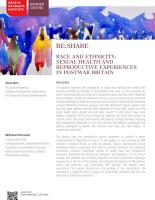Timeline: 2023-2028
Funding institution: Swiss National Science Foundation in the framework of project leader Caroline Rusterholz’s Eccellenza Professorial Fellowship.
Background
In 2020, the State of the Nation Report on Sexually Transmitted Infections (STIs) in England highlighted disparities in sexual and reproductive health (SRH), including difficulties in accessing SRH services, delay in receiving treatments and higher rates of STIs. Age, urban vs rural areas, poverty and ethnicity were presented as key factors in explaining these inequities in SRH. While the report stressed differences in STIs rates by ethnicity, it lamented the lack of research on the impact of the wider structural context and called for studies to address ‘the impact of racism’ in particular.
This project answers this call by examining the racialisation of SRH services provided by charities over time, i.e. the processes by which racial meanings are attached to particular issues that are often treated as social problems. During the twentieth century, issues around race (the perceived biological difference linked with physical characteristics), ethnicity (the perceived cultural differences between groups), and SRH generated regular debates. But how did these debates emerge? Who mobilised to bring these issues onto the public health policy agenda and with what results? To what extent have these debates impacted SHR services offered by charities and with what effects on service users? This project will examine the dynamic interplay between changing and manipulated categories of race and ethnicity and medical stereotypes and policies developed by British SRH charities over time, and their impact on minoritised individuals. This project is focused on voluntary organisations, i.e charities, who have lobbied and tried to influence the medical profession and NHS.
Banner: © SuriyaPhoto | Shutterstock.com







